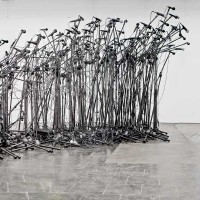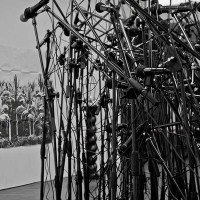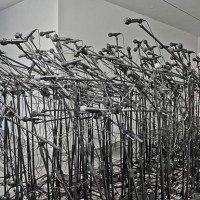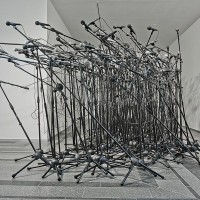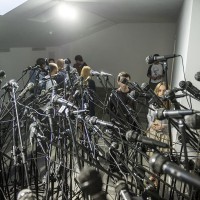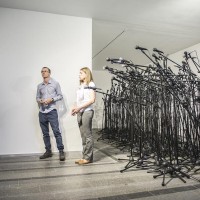THE END OF RADIO
audio installation
2012
___________________________________________________
exhibited:
• It's ON @ Leto Warsaw PL
• Coming Soon @ Temporary Cologne DE
• TheEnd Of Radio @ Manhattan Lodz PL
• TheEnd Of Radio @ P.A.C. Kiev UA
• Twisted Entities
- Contemporary Polish Art @ Museum Morsbroich
Leverkusen,DE
____________________________________________________
The End of Radio is an audio installation consisting of nearly two hundred microphones on stands, which send out signals instead of receiving them. This reversal of the primary function of the microphone alludes to the increased emission of signals which are more and more difficult to assimilate. It seems that the energy of the recordings from a street survey, which the artist used for the installation, has been preserved, even though the sound has been transformed so much that you can only hear interference or individual words. The title has been borrowed from a song by the band Shellac which poses the question whether transmission is still possible without any listeners.
____________________________________________________
It's on.
TXT by Vincent Ramos
I initially imagined the installation of “It’s on” as if at one moment the viewer is aurally assaulted only to escape into another space where, sound-wise, something more controlled and rational is taking place, thus giving him or her some respite. The intriguing thing with Konrad and his overall practice is you never know which space is which for him. Where the peace lies with him, where solace is generated. Could it actually be within the chaos of the utterly aggressive moment or is he like the majority of us, where it lies in the traditional quietude of the subtlest of gestures?
Later that day he sends me computer generated maquettes and working notes/sketches showing the spaces of the gallery with the work placed within. It was then that I realized that I was wrong. There is no safe haven. No rest stop. No transition. Nothing. If I understand this correctly, they both fuck with you. If I understand this correctly, the quietude, or something remotely akin to it, simply ain’t there. Shit, he isn’t like us.
Can you hear me now?
Can you hear me now?
Can you hear me now?
- The End of Radio- Shellac
It's center is the jumble of microphones catching nothing but themselves and as a result, feeding off of each other and turning the results onto the viewer or, I should say, listener. Konrad is in contemporary Warsaw and if you google his name, the first image that comes up is the artist, face-masked and bare-chested, clutching a reconfigured gutted missile attached to an amplifier more menacing looking than him. I’m assuming that “The End of Radio”, as well, fits perfectly within the social and political context of his moment, this moment, wherever he plugs it in.
As for that thing in the next space entitled, “It’s Bigger Than Me”, that thing right out of the catacombs of a North Hollywood prop house (ask Konrad about his experiences in nearby Sunland), that thing that looms over you in a way that transcends reality and digs deep into your inner most inner, it looks like it hurts. It looks like it comes from a cheap 1950’s Sci-Fi B-movie, like a thing designed to melt you from the inside out or something. Look for puddles around the base when you enter. I see in the working plans that there’s glass nearby. I hope that there’s tape spread across the exterior of that glass. They say that helps keep it intact when the storm penetrates, sonic or otherwise.
____________________________________________________
Brak możliwości
TXT by Daniel Muzyczuk
PL
„Tu jest za dużo możliwości. A w sztuce powinno być jak najmniej możliwości. Powinno ich prawie nie być. Gdyby na przykład zbudowano tu ogromną machinę, która wydawałaby jeden minimalny pisk – to wtedy dla mnie byłby to teatr muzyczny.” Tak w 1966 roku Tadeusz Kantor krytykował trwający 5 dni seans audiowizualny w Galerii Foksal, przygotowany przez Grzegorza Kowalskiego, Zygmunta Krauze, Henryka Morela i Cezarego Szubartowskiego. Artyści i kompozytor wypełnili wnętrze klamotami znalezionymi na złomowisku, z których zbudowali aparaturę – zaproszenie do uczestnictwa i współtworzenia eksperymentu. Każde pomieszczenie zmieniła ona w otoczenie odmienne tak pod względem wizualnym, jak i dźwiękowym. Prepunkowa energia, która przyprawiła o zgrozę Kantora, była odkryciem radosnego współgrania, bez ingerencji wzmacniacza.
Konrad Smoleński odpowiedział na wezwanie Kantora 46 lat później. Radość intermedialnego happeningu zastąpiła groza amplifikacji i groźba porażenia prądem. Śmietnisko zostało zastąpione zgrzebną mgławicą mikrofonów. „Koniec radia” to tytuł instalacji dźwiękowej, ale i kompozycji grupy Shellac. Smoleński znów odkrywa miejsca gdzie przepływ prądu ożywia materię i jest zwiastunem zniszczenia. Ciche trzaski pozwalają usłyszeć głosy, ale nie je zrozumieć. Ścieżka dźwiękowa do horroru? Być może, ale takiego, który nagrany jest zaraz po koncercie, kiedy zapach krwi i potu miesza się z zaprojektowanym przez La Monte Younga dronem, poprzez którego słychać Władimira Majakowskiego, a poeta wykorzystał zjawisko Electronic Voice Phenomena żeby powiedzieć Iggiemu Popowi „Pluj!”. Możliwości jest więc być może jak na kantorowskie standardy aż za dużo. Minimal music mówi językiem punk, wykorzystując jednocześnie jako strukturalną podstawę okultystyczne badania fal radiowych. Ale pisk jest zjawiskiem jednolitym. Nie ważne do którego z tych porządków należy. Ważne jaką formę teatru muzycznego kreuje.
Ten teatr wyraźnie jest obecny w drugiej pracy prezentowanej na wystawie. „Oscylacje” to praca o charakterze wręcz hakerskim. Na służącym do odczytu fal dźwiękowych urządzeniu Smoleński wyświetla falowanie tłumu na koncercie. Cisza nie pomaga nam w rekonstrukcji dźwięku, który powoduje, że ludzkie ciała tworzą kształty przywodzące na myśl sinusoidalne układy. Połączenie technologii, która przywodzi na myśl modernistyczne badania nad naturą dźwięku z brudem punkowego koncertu ponownie dochodzi do głosu w twórczości Smoleńskiego. Oczyszczenie formy służy eksploracji mikroeksplozji, które najlepsze efekty uzyskują na taśmie magnetofonowej.

